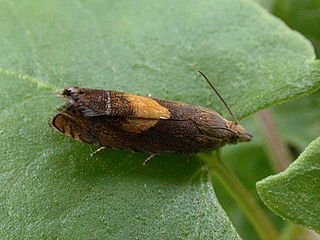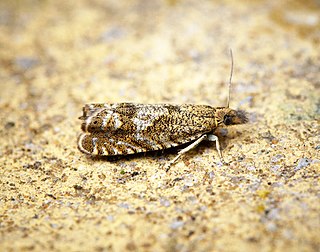
Caradrina morpheus, the mottled rustic, is a moth of the superfamily Noctuoidea. The species was first described by Johann Siegfried Hufnagel in 1766. It is found across the Palearctic from northern Europe to Siberia, Amur and Korea. Also in Armenia and Turkestan. It was accidentally introduced on both the east and west coasts of Canada and is so far reported in the east from New Brunswick to Ontario, and in the west from British Columbia.

Dichrorampha acuminatana is a moth of the family Tortricidae. It is found in Europe and the Near East.

Dichrorampha petiverella is a moth of the family Tortricidae. It is found in the Palearctic realm.

Epinotia tedella is a moth of the family Tortricidae. It is found in Europe.

Parapoynx stratiotata, the ringed china-mark, is a moth of the family Crambidae. The species was first described by Carl Linnaeus in his 1758 10th edition of Systema Naturae. It is found in Europe where the distribution area extends in the north to the British Isles including Ireland and in the south to Sardinia, Sicily and Greece. The species is also found across the Palearctic in North Africa, Lebanon, Turkey, Azerbaijan, Kyrgyzstan, Uzbekistan and China..

Falcaria lacertinaria, the scalloped hook-tip, is a moth of the family Drepanidae. The species was first described by Carl Linnaeus in his 1758 10th edition of Systema Naturae It is found in Europe and Anatolia then east to Eastern Siberia.
Poecilasthena cisseres is a moth of the family Geometridae first described by Alfred Jefferis Turner in 1933. It is found in Australia, including Victoria.

Orthotelia is a genus of moths in the subfamily Orthoteliinae.Orthotelia sparganella, a moth of the family Glyphipterigidae, is its only species.

Dichrorampha alpinana, the broad-blotch drill, is a species of moth of the family Tortricidae. It is found in almost all of Europe.

Grapholita janthinana, the hawthorn leafroller, is a moth of the family Tortricidae. It was described by Philogène Auguste Joseph Duponchel in 1843. It is found in most of Europe, except most of the Balkan Peninsula, Ukraine, Lithuania and Estonia. The habitat consists of hedgerows, gardens and woodland edges.

Epinotia nemorivaga, the bearberry bell, is a species of moth in the family Tortricidae. It is found in Europe and Asia.
Anaptilora ephelotis is a moth in the family Gelechiidae. It was described by Edward Meyrick in 1916. It is found in Australia, where it has been recorded from the Northern Territory.
Dichomeris turrita is a moth in the family Gelechiidae. It was described by Edward Meyrick in 1914. It is found in Guyana and Brazil.
Dichomeris fungifera is a moth in the family Gelechiidae. It was described by Edward Meyrick in 1913. It is found in Assam in India, northern Vietnam and Jiangxi, China.
Hypatima caryodora is a moth in the family Gelechiidae. It was described by Edward Meyrick in 1913. It is found in Assam, India.
Idiophantis habrias is a moth of the family Gelechiidae. It was described by Edward Meyrick in 1904. It is found in Australia, where it has been recorded from Queensland.
Antaeotricha monosaris is a moth of the family Depressariidae. It is found in Guyana, French Guiana and Brazil.
Imma tetrope is a moth in the family Immidae. It was described by Alexey Diakonoff in 1978. It is found in Nepal.

Dichrorampha plumbagana is a moth belonging to the family Tortricidae first described by Georg Friedrich Treitschke in 1830.

Dichrorampha plumbana is a moth belonging to the family Tortricidae first described by Giovanni Antonio Scopoli in 1763. It is native to the Palearctic including Europe.












